The Swiss Cheese Plant, widely referred to as Monstera deliciosa, has become a common houseplant choice for its attractive, interesting leaves that have holes in them and its tropical feel, which comes from its origins in the rainforests of South America, Mexico, and Central America. Whichever you prefer to call it, it is worth the attention and effort. Its distinctive leaves are bold and majestic, with deep splits and fenestrations, and its glossy leaves are a key decorative feature, adding vibrant art to a room.
Although they may seem exotic, these plants are quite easy to care for, making them suitable for various skill levels, from novice to experienced growers. The Swiss cheese plant is also a fast grower, making it ideal for beginners who want to see quick results. Monstera adansonii, a related species, also features unique leaf holes and similar care needs, making it another popular choice for plant lovers. For more ideas on how plants can fit into your overall living space, explore our guide on living room layout ideas.
This guide will help you understand everything you should know about Swiss Cheese Plant care, including how and when to water them, their light requirements, soil types or potting medium, and much more, so your plant can grow healthy and flourish for you indoors.
Category – Swiss Cheese Plant
This plant was first known because of the unique characteristics of its leaves that make it look like there are holes in them; as the leaves mature, they develop holes, which is a distinctive feature of the species. The plants are the Pacific equator rain forest locals, and they can grow quite wide in their natural habitat. In the wild, Swiss cheese plants use aerial roots to climb trees and grow tall, taking advantage of support structures to reach sunlight. In the house, they can only be grown after burning the leaves or cutting the branches that overgrow the trees; thus, properly, they are not very good outdoor Hespirids.
Swiss Cheese Plant Identification
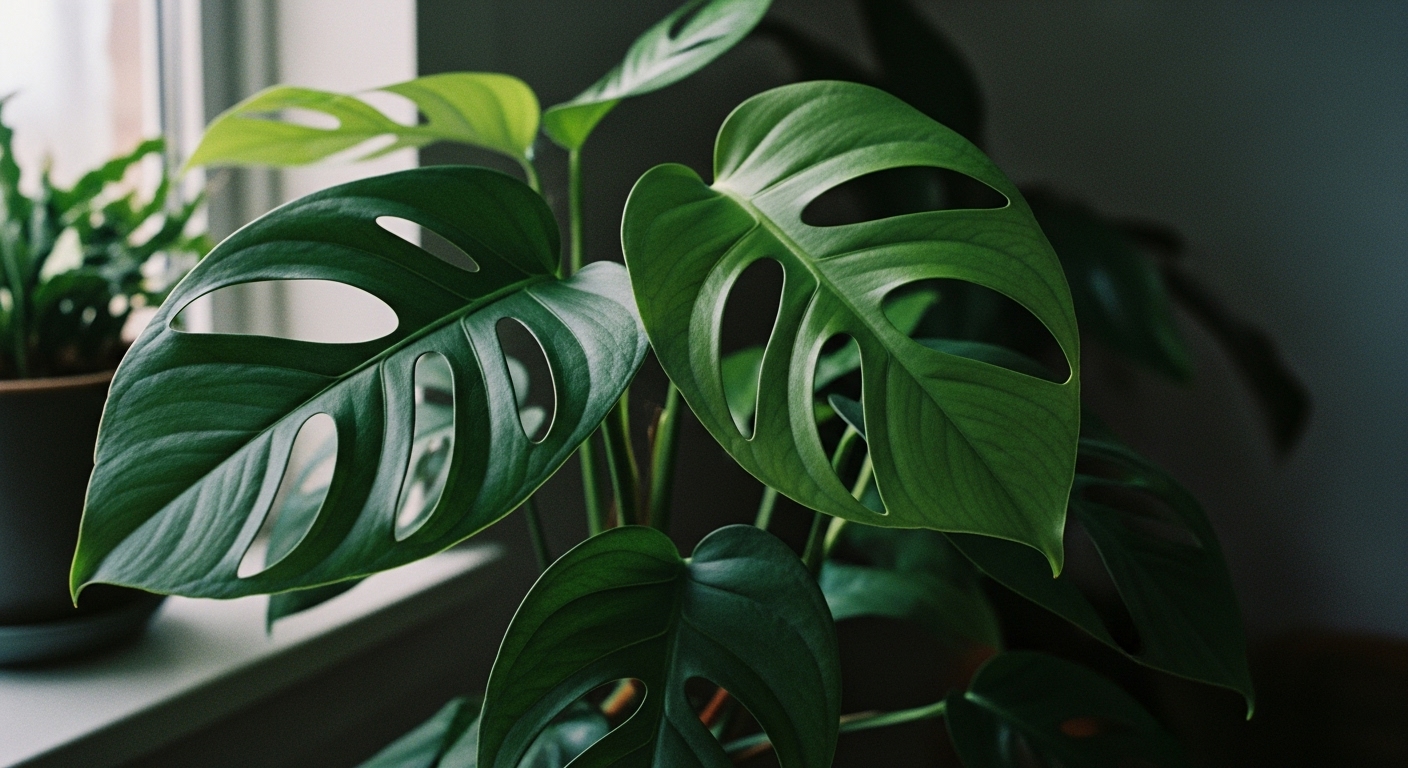 Swiss cheese plants are huge, with green leaves having natural holes and ruptures. The monstera plant is known for its dramatic foliage. They are very long to climb and acquire a lot of space when they temperament over them. The monstera swiss cheese plant care routine is necessary for their longevity and appearance. As the plant matures, new leaves will gradually develop holes, which is a sign of a healthy Monstera adansonii.
Swiss cheese plants are huge, with green leaves having natural holes and ruptures. The monstera plant is known for its dramatic foliage. They are very long to climb and acquire a lot of space when they temperament over them. The monstera swiss cheese plant care routine is necessary for their longevity and appearance. As the plant matures, new leaves will gradually develop holes, which is a sign of a healthy Monstera adansonii.
Light Requirement
Cheese plants generally grow better in environments with filtered, indirect light. Swiss cheese plants benefit from a few hours of gentle morning sun but should be protected from harsh afternoon rays. Their leaves get sunburned near windows with direct sunlight, as too much direct sunlight can burn the leaves. The plant thrives in bright, indirect sunlight and can also tolerate medium light conditions, but may not develop as many leaf splits if it doesn’t get enough light. Keep them in the window nearest to a room that has dim light, and you’ll need to use your judgment whether you want to go elsewhere for the first 2-4 weeks to pace yourself and catch your breath from the overwhelming new environment. Placing the plant in a spot with enough light is crucial for healthy growth and leaf development.
How to Pick the Right Spot
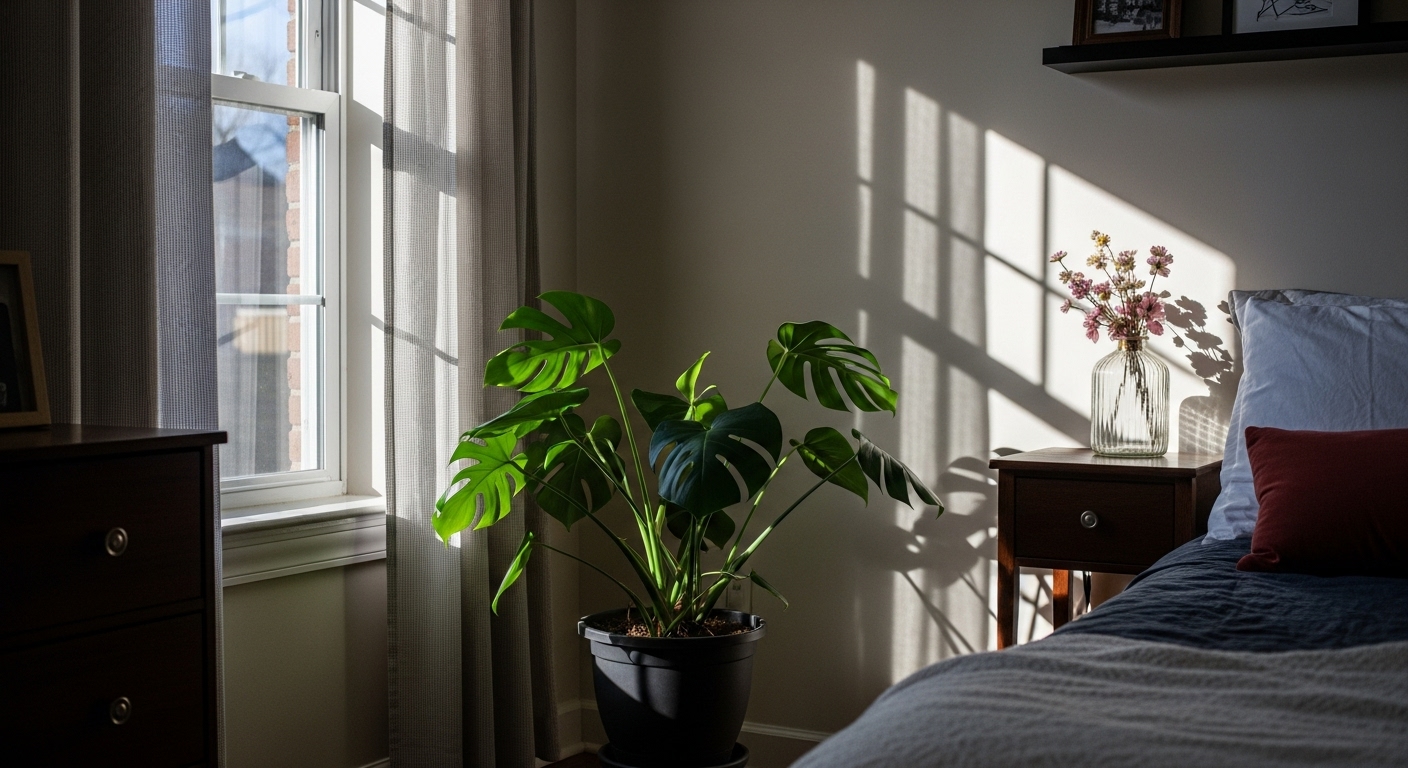 For appropriate Swiss cheese plant care, you have to find a spot with a stable light level. A room, which is very dark or where the radiation from the sun is extremely strong, should be avoided. The room where curtains or blinds have been installed is perfect for controlling light conditions in your house.
For appropriate Swiss cheese plant care, you have to find a spot with a stable light level. A room, which is very dark or where the radiation from the sun is extremely strong, should be avoided. The room where curtains or blinds have been installed is perfect for controlling light conditions in your house.
Watering Demands
Being a good attendant to the Swiss cheese plant, one should anticipate the fact that his or her plants will always come across those dry periods when the moisture will become scarce. Overwatering can lead to soggy soil, which should be avoided as it can harm the plant. These plants grow well in moist, well-drained soils, but it is important to allow the soil to dry out between waterings and not let it become waterlogged. The type of growing medium used can also affect how often the plant needs water.
When to Water
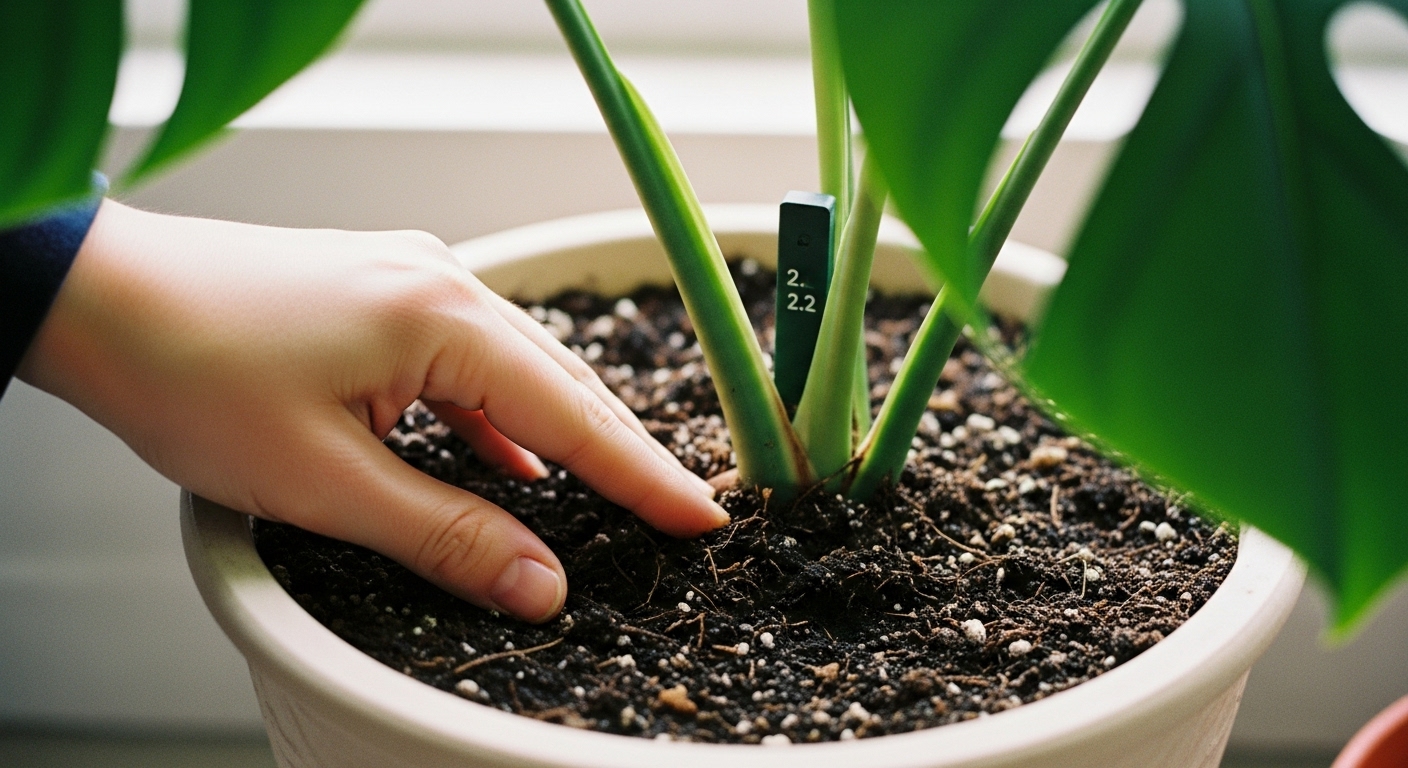 Turn the faucet on when the snow has melted slowly on the top inch of soil. Cut back on watering when the days are shorter and temperatures have fallen. Furthermore, too much water causes the roots to rot; therefore, use caution.
Turn the faucet on when the snow has melted slowly on the top inch of soil. Cut back on watering when the days are shorter and temperatures have fallen. Furthermore, too much water causes the roots to rot; therefore, use caution.
Soil and Repotting
A suitable potting mixture for Swiss cheese plants has well-drained soil. A high-quality potting mix is essential for healthy root development. The commonly used blend of potting soil, peat moss, and perlite is a great option. The plant growing a few inches every year can be translated to the new pot, where it is a little bit bigger. When roots start to poke through drainage holes or appear above the soil, it’s time to move the plant to a larger pot. Using appropriately sized pots helps support the plant’s growth and prevents root crowding.
Quality Pot Selection
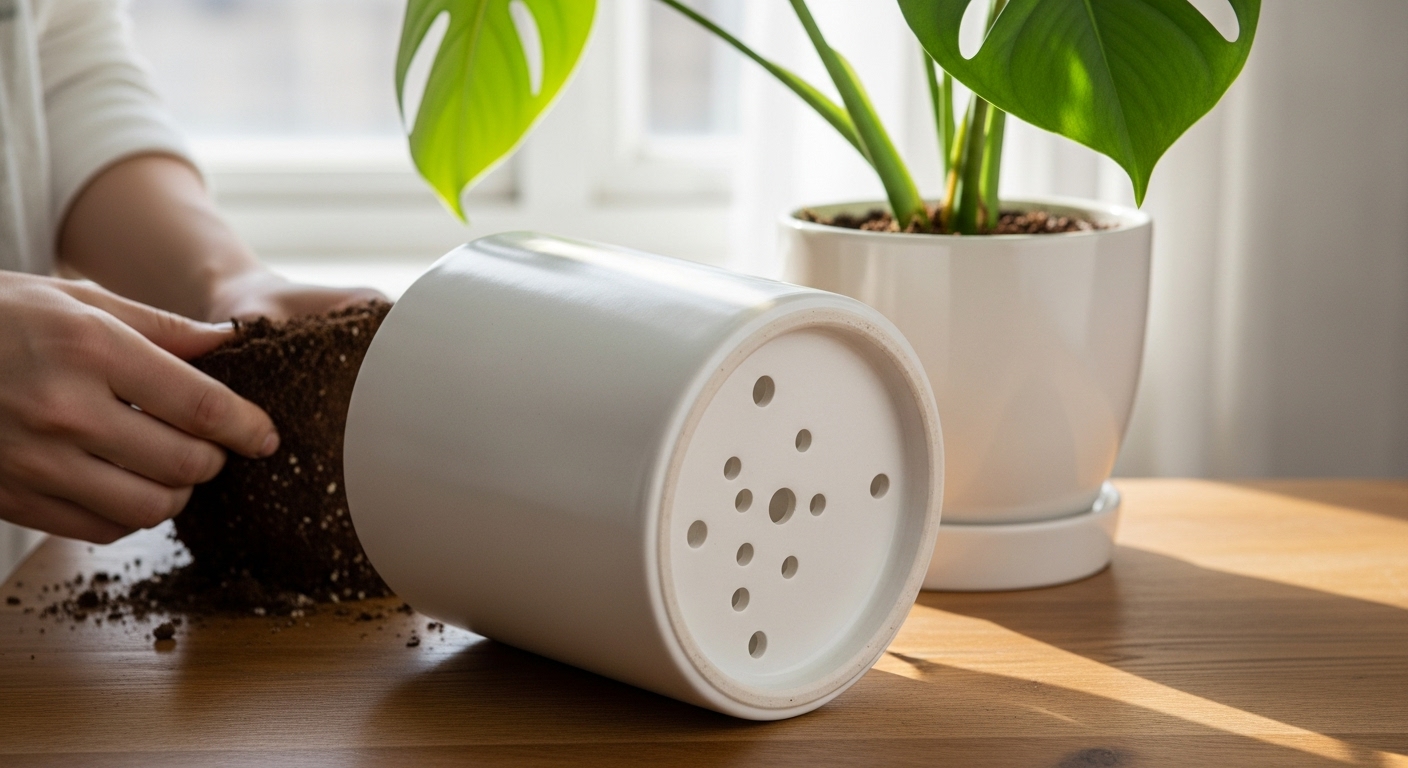 Find a container with workable drainage holes in it. Do not allow water from the bottom to pile there, as that could rot roots.
Find a container with workable drainage holes in it. Do not allow water from the bottom to pile there, as that could rot roots.
Moisture and Temperature
Swiss cheese plants like humid conditions and tolerate temperatures in the range of 65-80F.
Like other tropical plants, Swiss cheese plants thrive in a warm environment with high humidity, which helps support their healthy growth.
Ways of Boosting Humidity
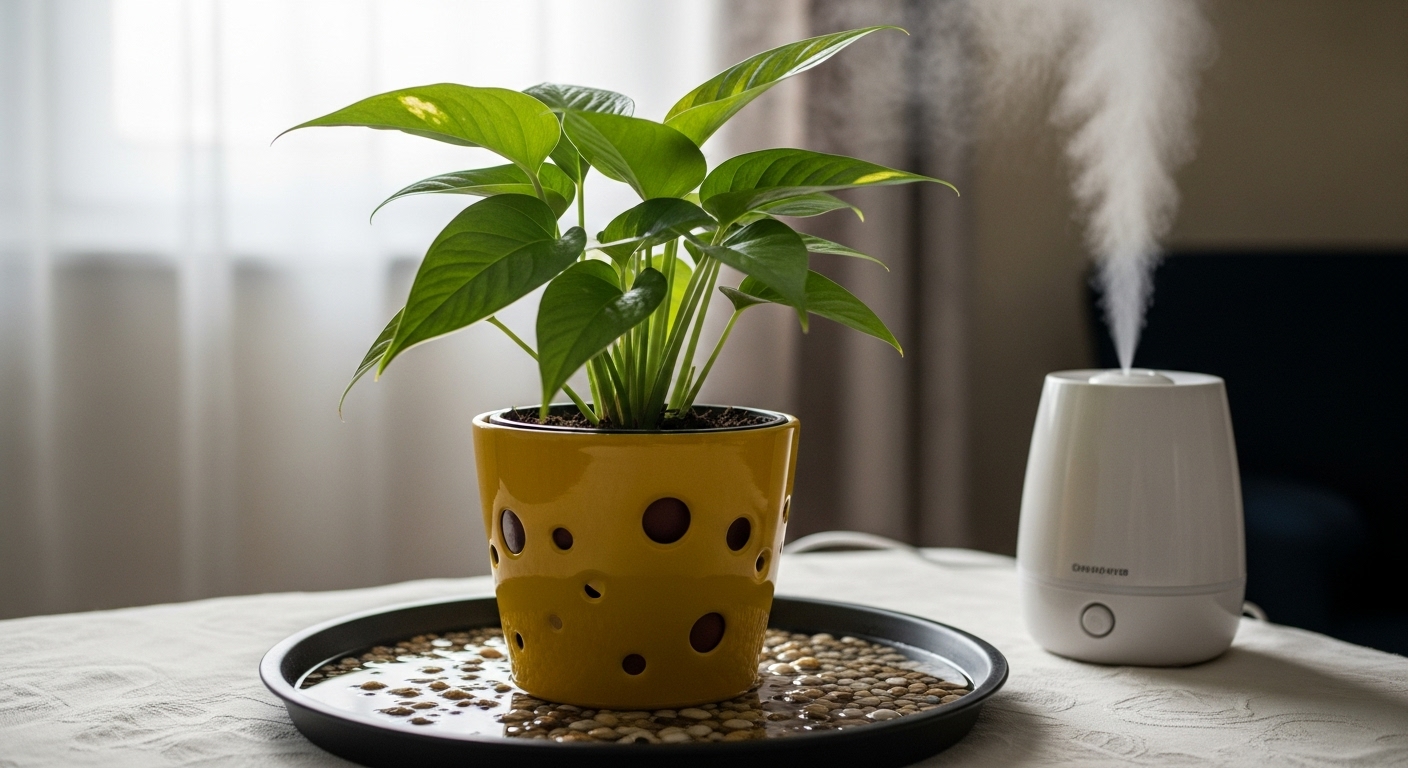 Indoors, where there is low humidity, a room humidifier or a sprinkling of the leaves with water will keep the air moist. Put the container of your plant on a layer of pebbles with water so the water evaporates faster and raises the humidity level.
Indoors, where there is low humidity, a room humidifier or a sprinkling of the leaves with water will keep the air moist. Put the container of your plant on a layer of pebbles with water so the water evaporates faster and raises the humidity level.
Fertilizing Swiss Cheese Plant
During the growing season, application of a balanced water-soluble fertilizer is one of the key elements that lead to success. This will enable good growth and leaf development in the plant. Always follow the package directions when applying fertilizer to avoid overfeeding.
Fertilizing Application
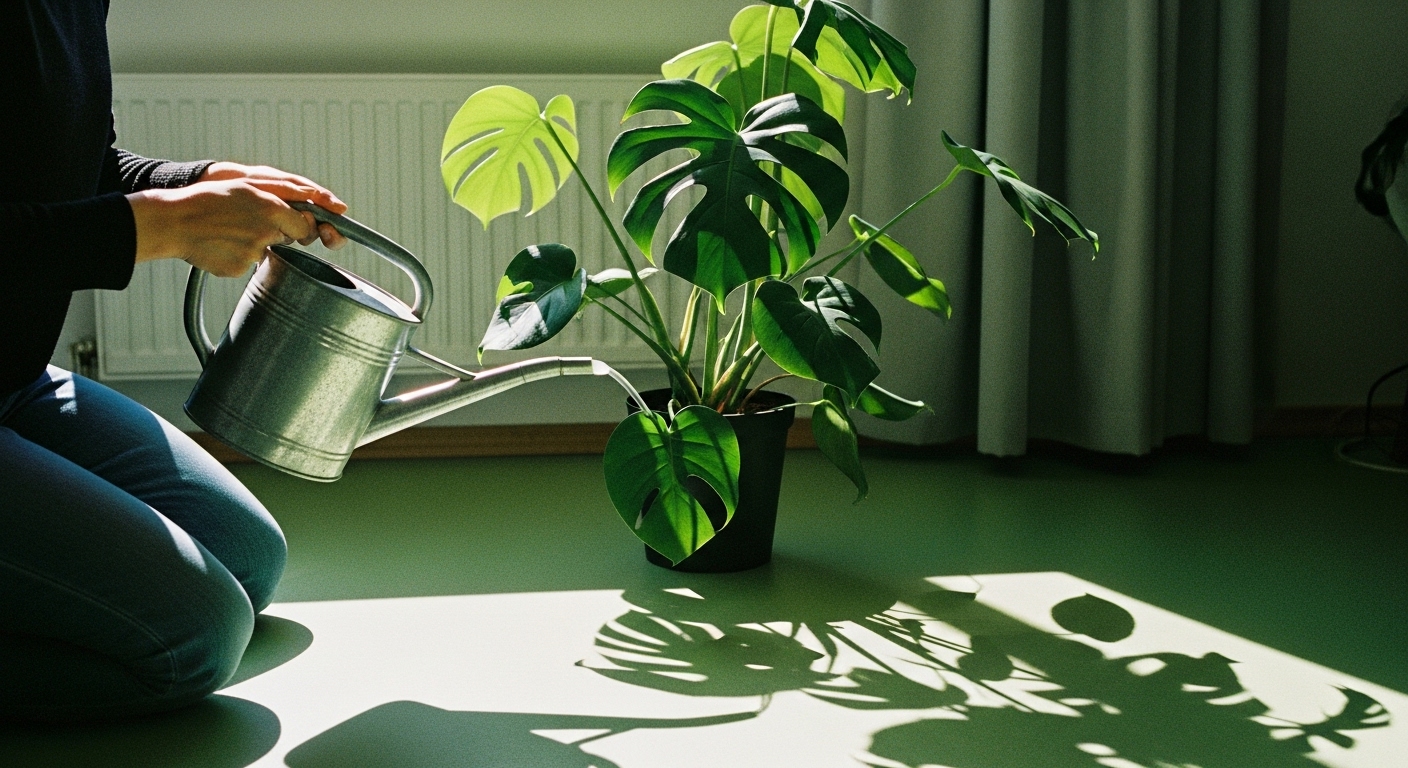 It is recommended to fertilize every four weeks in the case of tender birds and get rid once and for small numbers often, or it is up to the driver to decide and do so. Shrubs stop growing in the fall and during the winter season, and the fertilizing of them will decrease and eventually stop.
It is recommended to fertilize every four weeks in the case of tender birds and get rid once and for small numbers often, or it is up to the driver to decide and do so. Shrubs stop growing in the fall and during the winter season, and the fertilizing of them will decrease and eventually stop.
Cutting and Keeping
Cuttings taken usually from the top part of the Swiss Cheese plants are used to make new plants, and healthy stems are essential for successful propagation. Yellow or damaged leaves should be removed from the plant to keep it healthy. Regular pruning encourages new growth. Swiss cheese plants are fast growers and may need frequent pruning or repotting to accommodate their vigorous development.
Blowing up the Plant
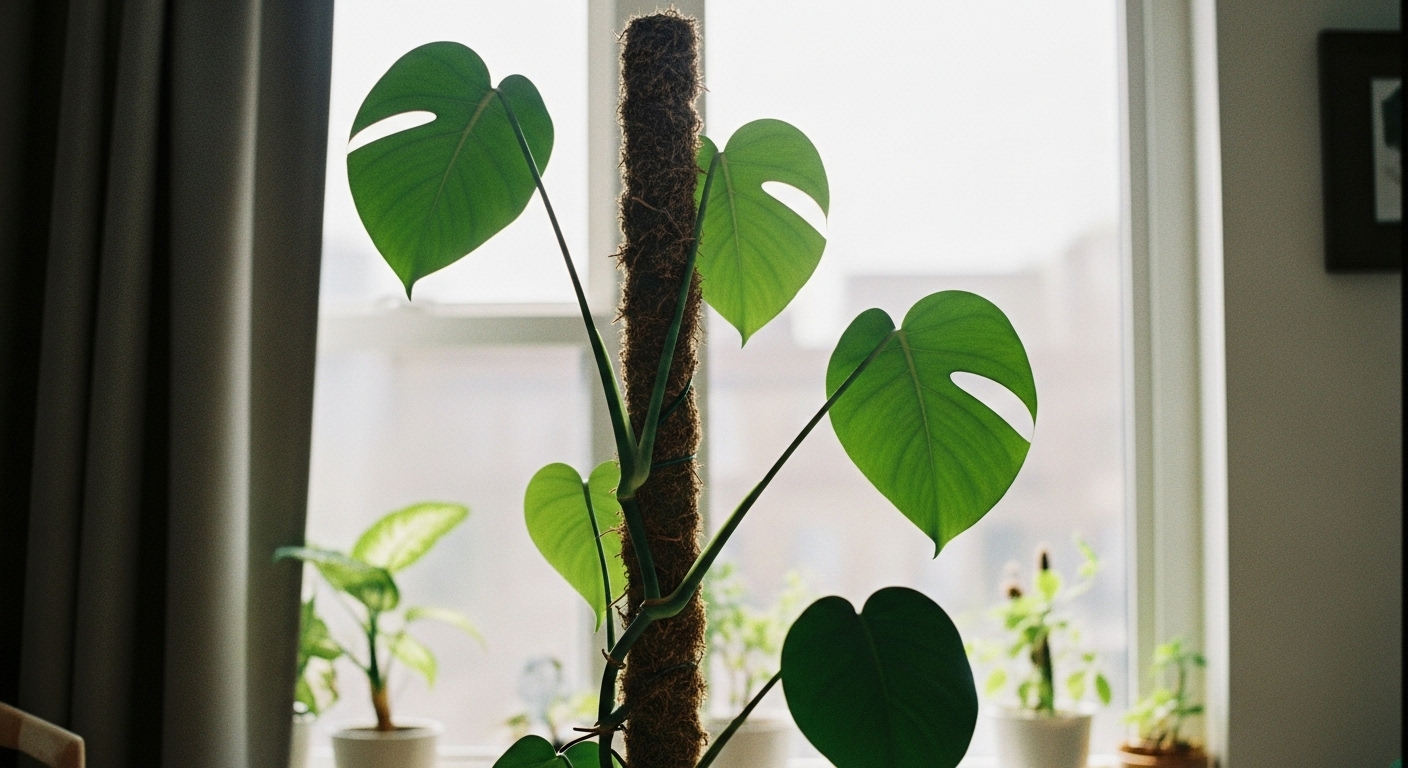 Being the plant grows, create a moss pole or a trellis to support it, as monsters climb by using aerial roots to attach themselves to supports, mimicking their natural growth habit. This way you will reproduce its normal climbing habit.
Being the plant grows, create a moss pole or a trellis to support it, as monsters climb by using aerial roots to attach themselves to supports, mimicking their natural growth habit. This way you will reproduce its normal climbing habit.
Pest Control for Swiss Cheese Plants
Occasions when Swiss cheese plants have pest problems are quite rare. Regularly removing dust from the leaves helps keep the plant healthy and less susceptible to pests. Some of the common ones are spider mites, mealybugs, and scale insects. For more detailed guidance on managing common houseplant pests, resources from university extension services can be invaluable. For identifying other common household pests, you might find our guide on insects that look like bed bugs helpful.
Dealing with Pests
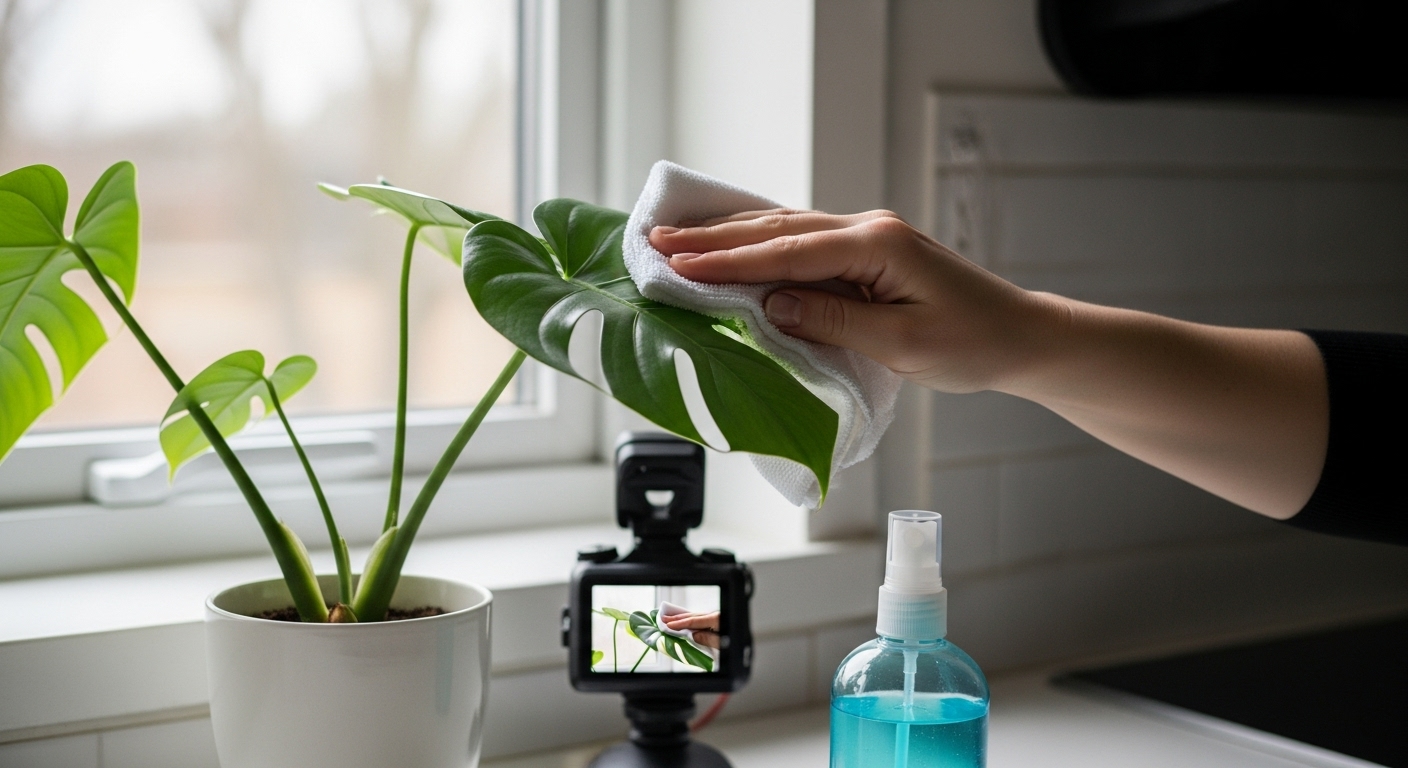 For instance, you can clean your plant’s leaves with a damp cloth as well as use eco-friendly dish soap to keep pests away. The worst condition can still be medicated; however, it is a little complicated. Keeping the infected plants away from the others is another way to stop the spread.
For instance, you can clean your plant’s leaves with a damp cloth as well as use eco-friendly dish soap to keep pests away. The worst condition can still be medicated; however, it is a little complicated. Keeping the infected plants away from the others is another way to stop the spread.
Leaf Problems and Solutions
By contrast, leaving brown leaf spots, yellow leaves, and leaf rolling untreated are the most common problems that occur in the care of the Swiss Cheese plant. Overwatering can lead to root rot, which is a common cause of wilting and yellowing leaves. The majority of the time, it can be an issue with the water, and not the light or the plant’s nutrition; yellow leaves or brown spots can be a sign of improper watering or humidity.
Addressing Leaf Issues
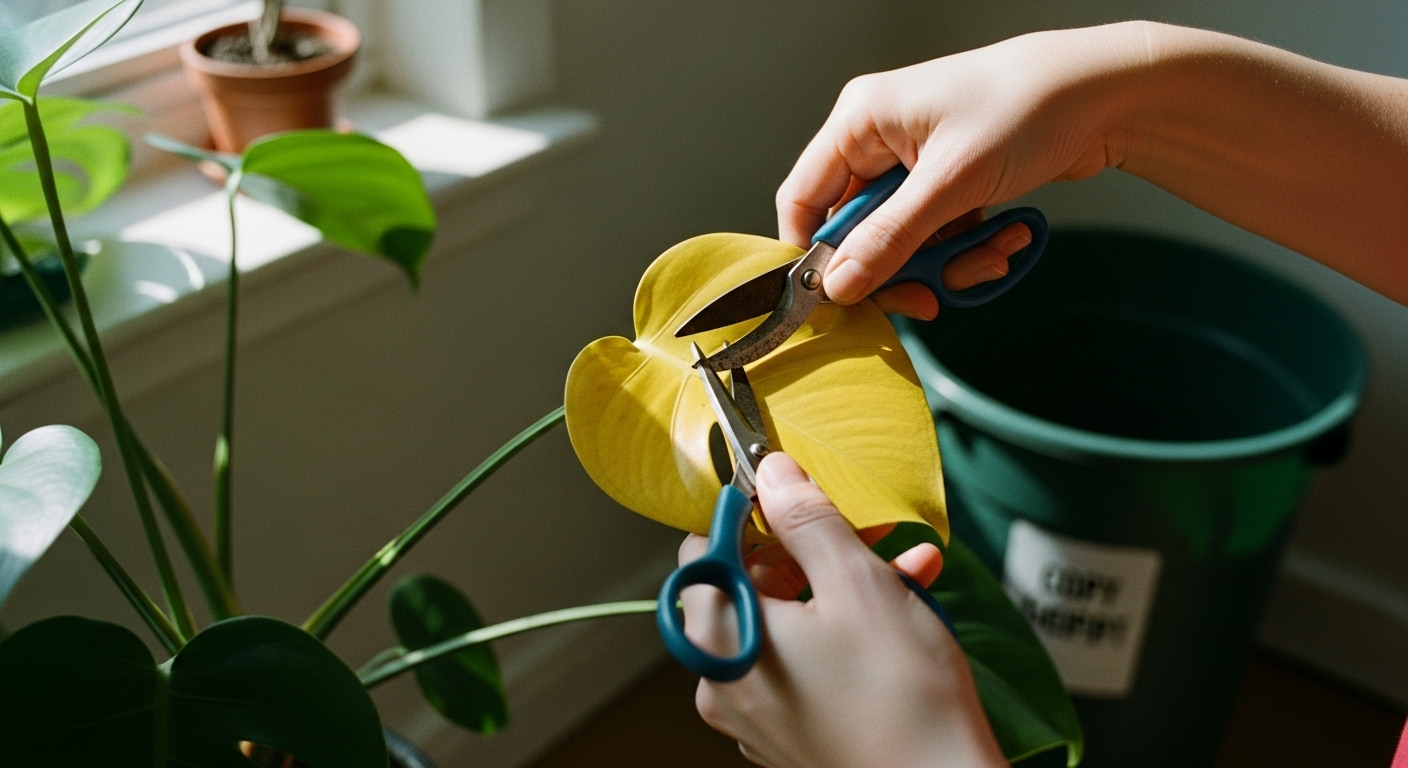 Be conscious of watering, and the need for illumination, and follow the prescribed fertilizer application protocol. Besides that, use the pruning method in which you remove the unhealthy leaves if you want the plant to have fresh leaves and, thus, a healthy appearance. Continuous care is what will help in preventing future problems.
Be conscious of watering, and the need for illumination, and follow the prescribed fertilizer application protocol. Besides that, use the pruning method in which you remove the unhealthy leaves if you want the plant to have fresh leaves and, thus, a healthy appearance. Continuous care is what will help in preventing future problems.
Seasonal Care for Swiss Cheese Plants
Despite the fact that Swiss cheese plant care takes different shapes with different seasons, the usual form of care for this plant does not change much. Spring is the best time for repotting, pruning, and propagating Swiss cheese plants, as this is when they are actively growing. The knowledge of seasonal changes enables the plant to get the best care every year.
Summer Care
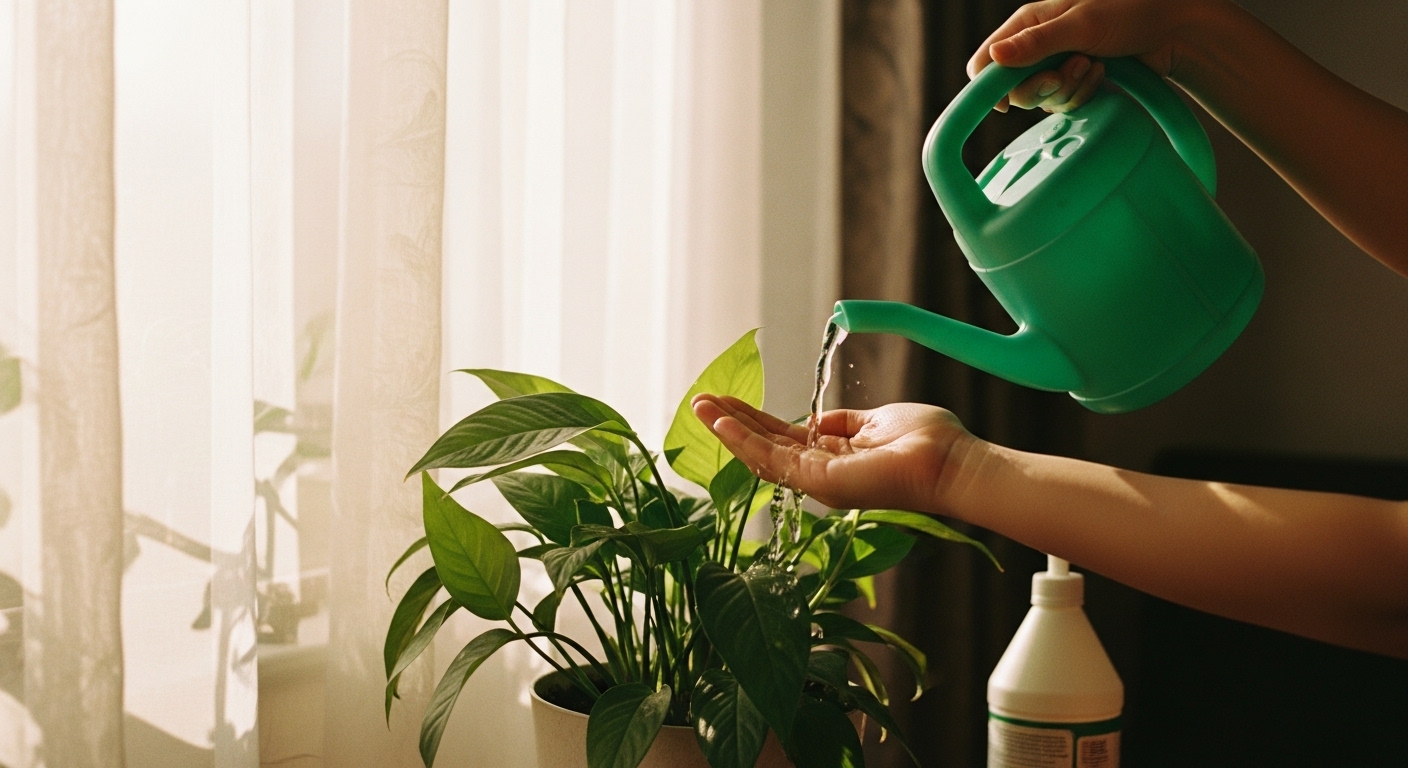 Give the plant more food and water, and keep it away from the intense sun in the warmer months. Make sure the plant does not become too hot as a result of direct sunlight. Also, feeding the plants is essential in the middle of summer.
Give the plant more food and water, and keep it away from the intense sun in the warmer months. Make sure the plant does not become too hot as a result of direct sunlight. Also, feeding the plants is essential in the middle of summer.
Winter Care
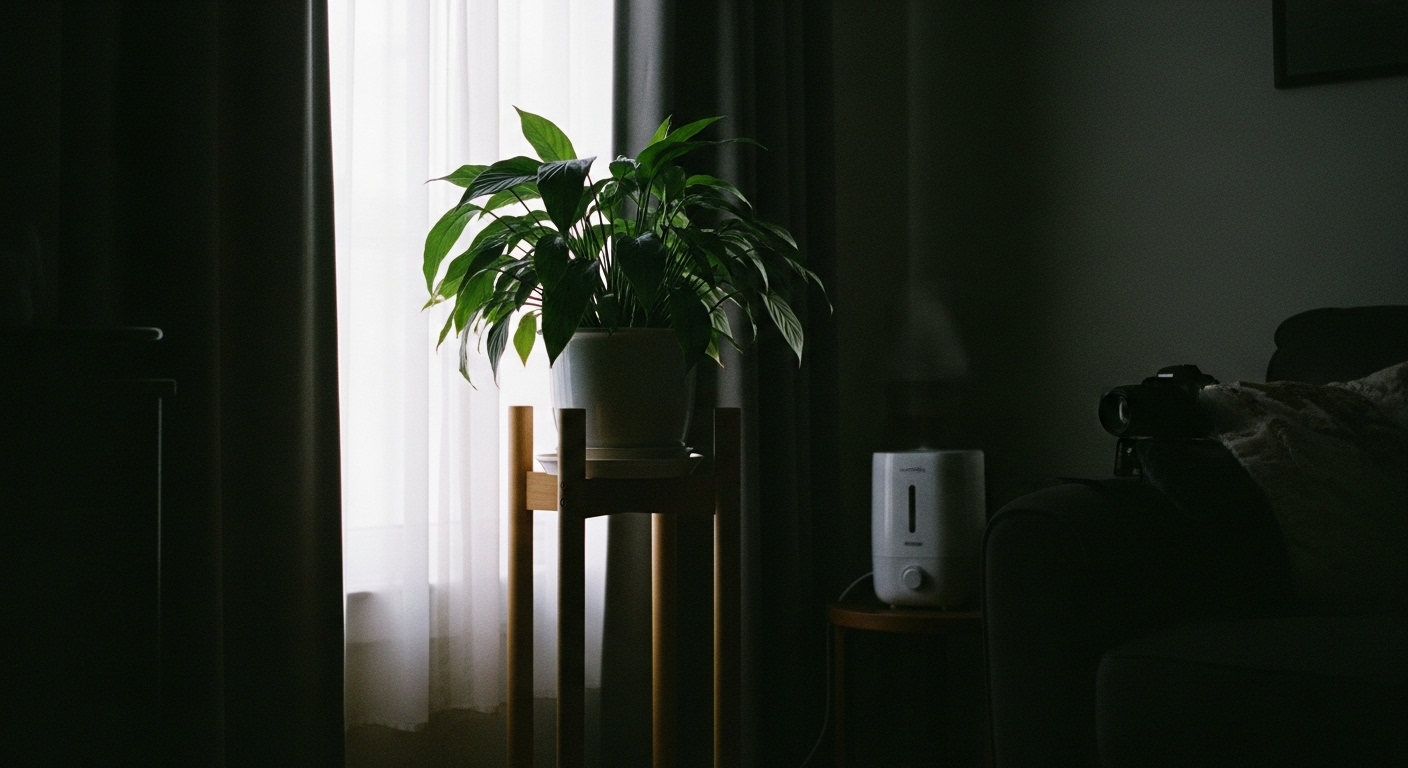 In the winter months, watering should be decreased, and no more fertilizer should be applied. The plates should also be moved away from cold drafts that might be blowing through your house, and the temperature should be kept at one constant level. The level of the humidity may need to be increased due to the dry indoor air>
In the winter months, watering should be decreased, and no more fertilizer should be applied. The plates should also be moved away from cold drafts that might be blowing through your house, and the temperature should be kept at one constant level. The level of the humidity may need to be increased due to the dry indoor air>
Propagation Techniques
Propagation offers a fun way for everyone to broaden their aroid’s belief. Aerial roots can be used in propagation methods such as air layering, making use of the plant’s natural growth habits. The methods of achieving this are many, each with its pros and cons.
Stem Cutting Propagation
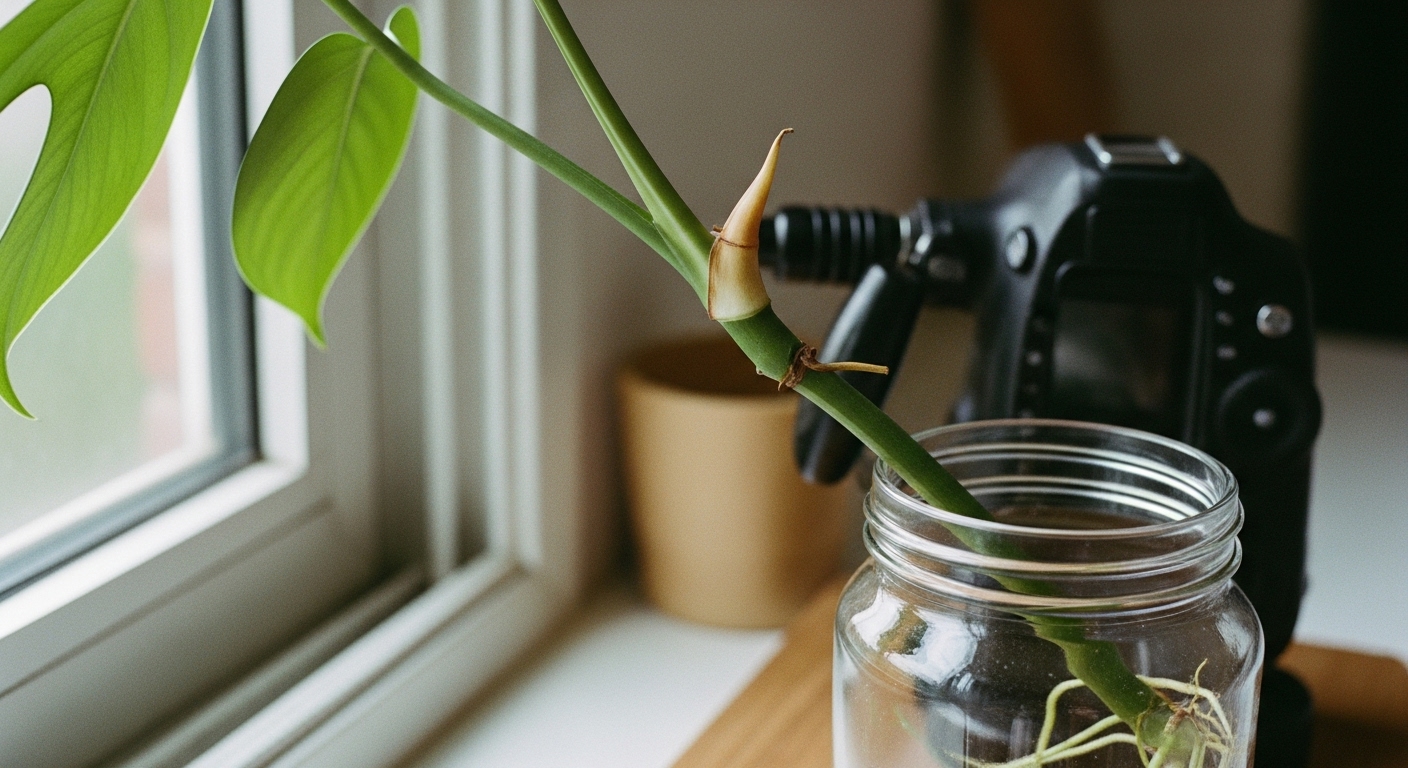 Most people prefer starting with this method. Which involves the pelvis, which has to be 1 node, and other leaves. Once placed in either water or moist soil, roots could develop within a few weeks. A particularly simple and highly efficient method it is!
Most people prefer starting with this method. Which involves the pelvis, which has to be 1 node, and other leaves. Once placed in either water or moist soil, roots could develop within a few weeks. A particularly simple and highly efficient method it is!
Air Layering
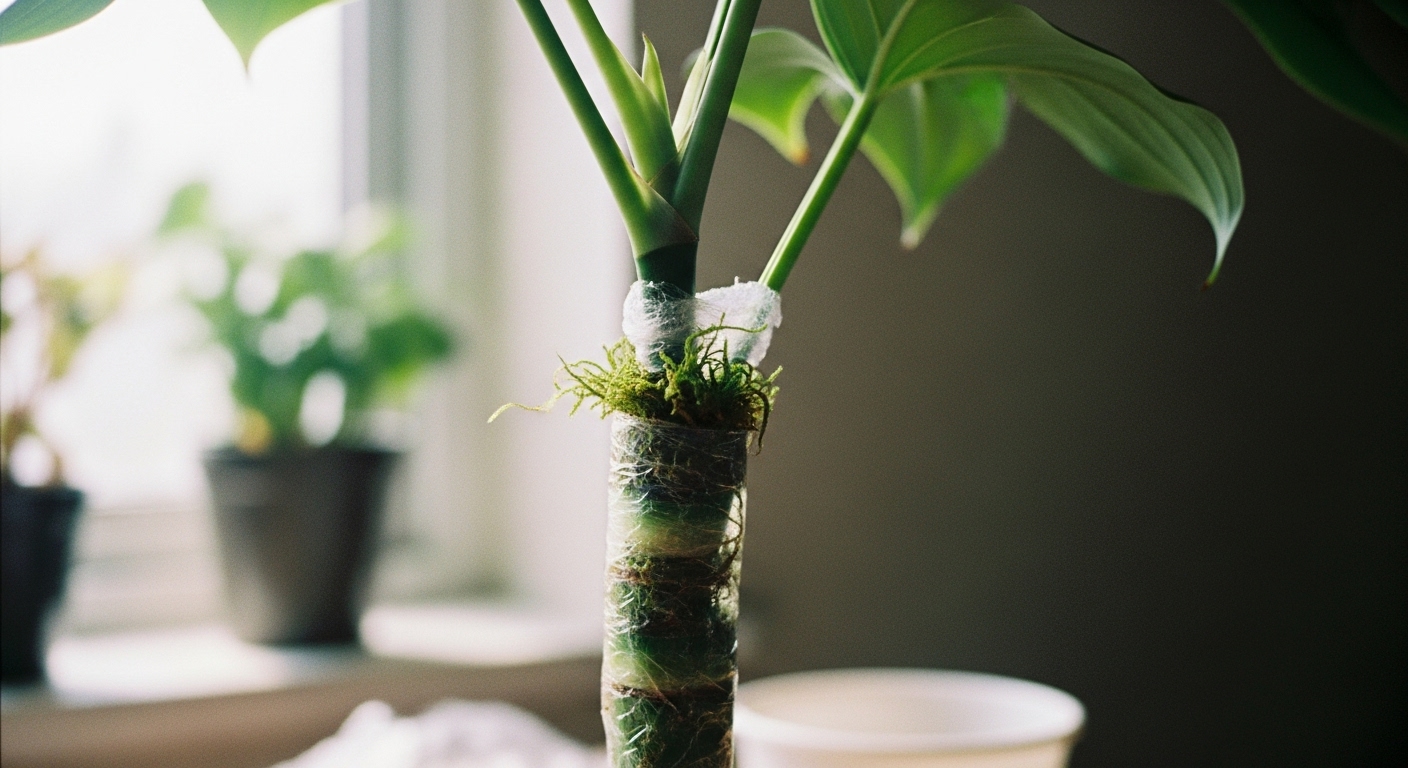 Air layering is another way of propagating plants. It is a process whereby the root of a plant grows while it is still connected to the parent.’ Using it on a larger plant to produce a robust root system before it can be separated is not the least of its advantages.
Air layering is another way of propagating plants. It is a process whereby the root of a plant grows while it is still connected to the parent.’ Using it on a larger plant to produce a robust root system before it can be separated is not the least of its advantages.
Decorating with Swiss Cheese Plants
Swiss cheese plants are relatively easy to take care of and, in addition, they can also serve as beautiful centerpieces and are good decorations for anywhere. The whole thing, including the plant’s large leaves and climbing stems, can serve as a dramatic focal point in any room. Large and one-of-a-kind, their often beautiful leaves add a tropical twist to interiors. For more tips on how to effectively integrate large decorative elements into your space, check out our article on decorating small spaces.
Placement Ideas
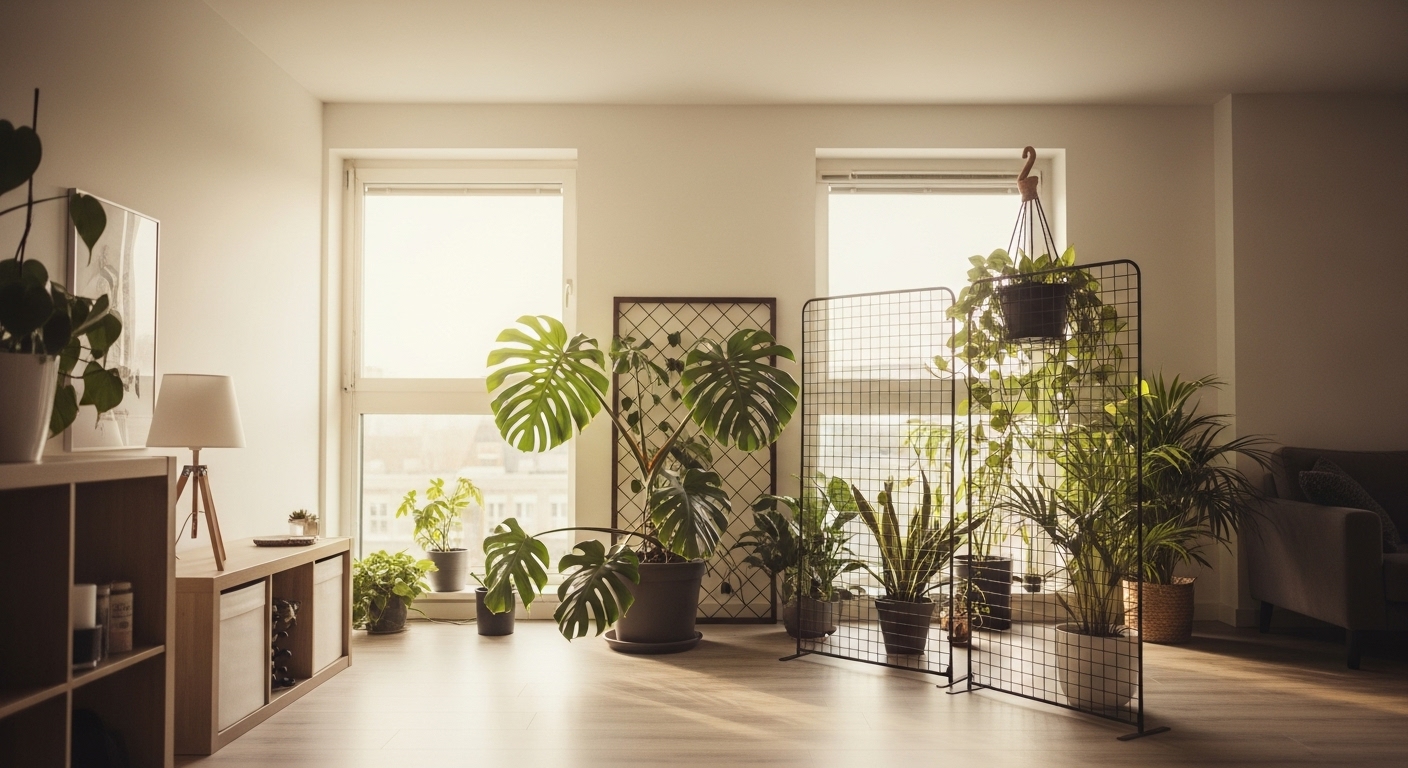 They can be placed in corners as a means of dividing space, or solo, and can be used as a focal point in a room. They can be completely turned into trellises if they possess climbing properties.
They can be placed in corners as a means of dividing space, or solo, and can be used as a focal point in a room. They can be completely turned into trellises if they possess climbing properties.
Benefits of Swiss Cheese Plants
Not just for their attractive looks, Swiss cheese plants have other benefits for the environment as well as the health of their owners.
Air Purification
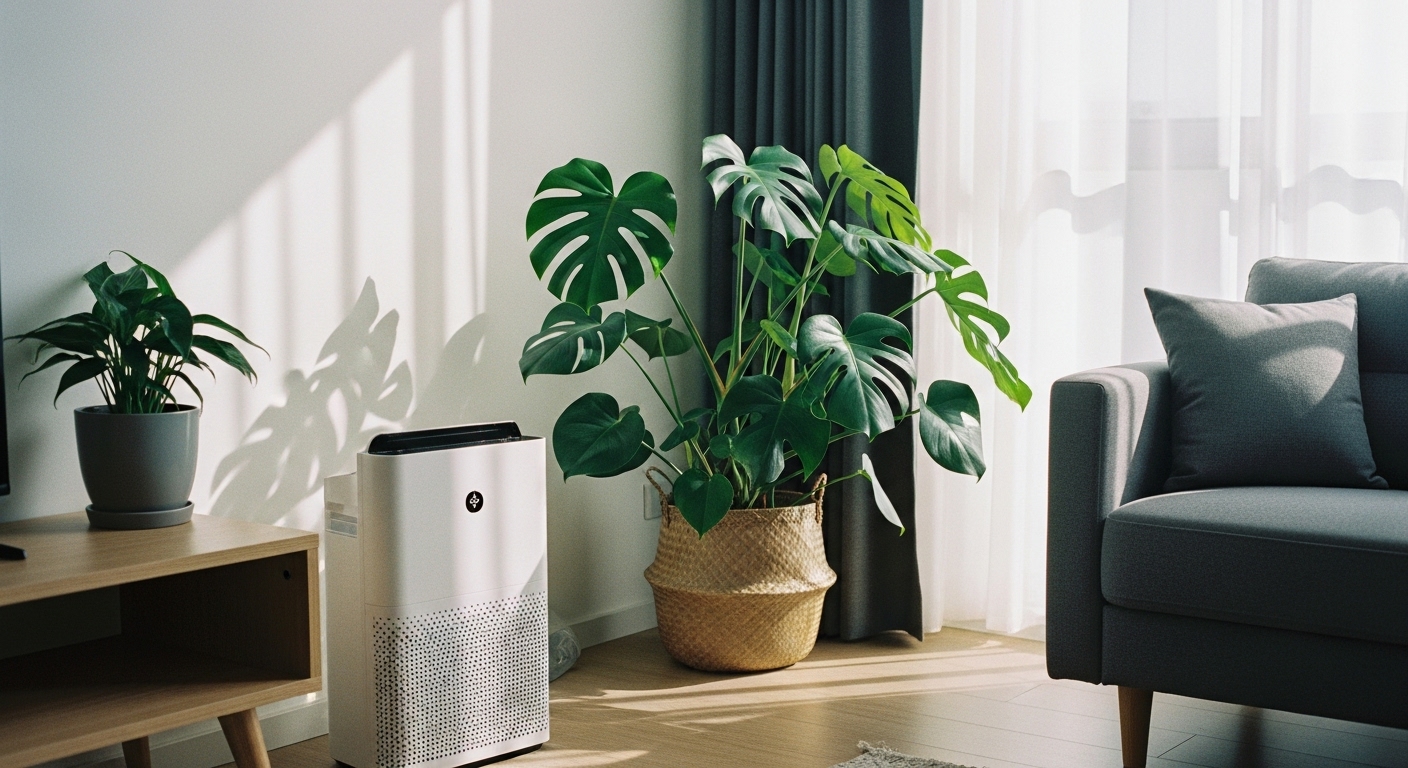
Various houseplants, including Swiss cheese plants, have air-purifying effects. They are helpful in eliminating indoor air pollution, thus making the air quality of your home or office better, as supported by NASA’s research on air-purifying plants.
Stress Reduction
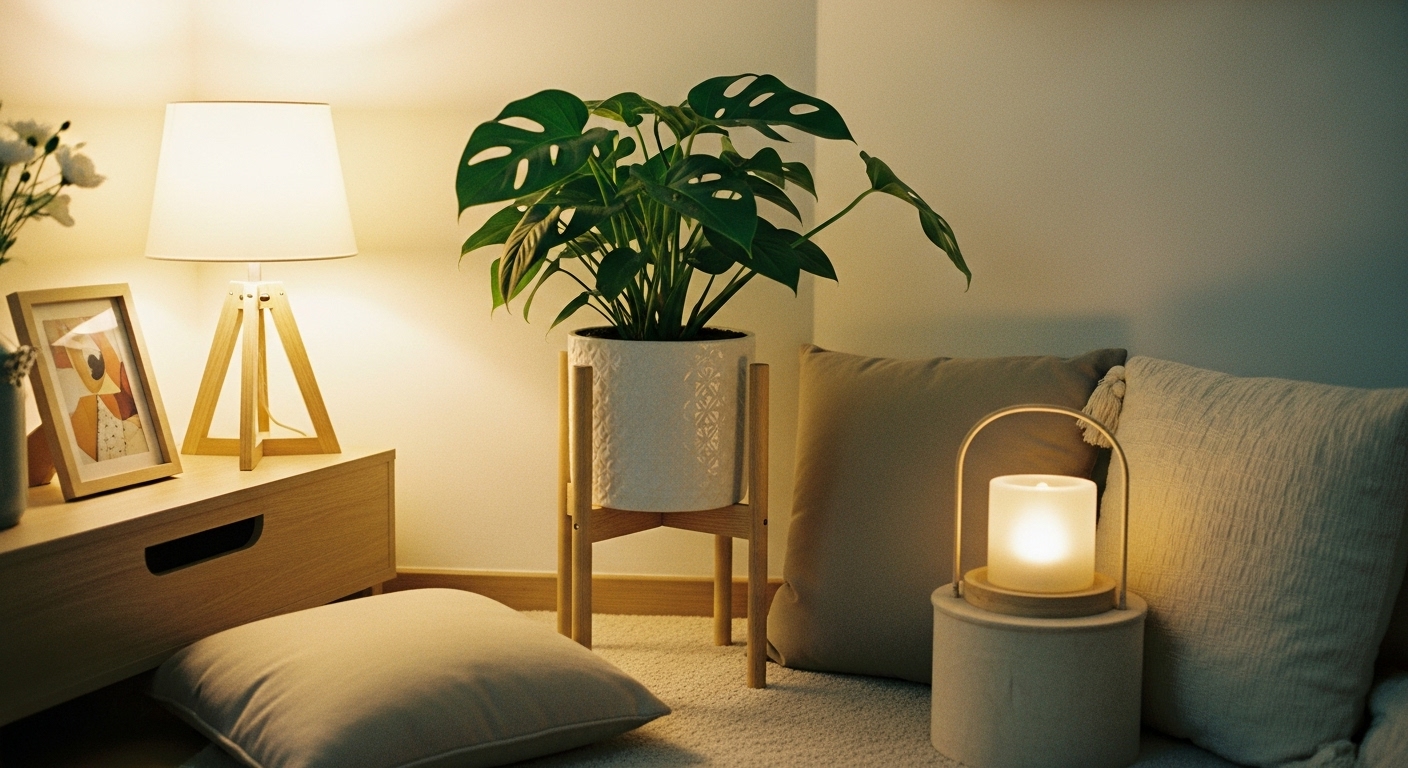 The presence of plants can indeed have a big impact on the stress levels that people have, causing a positive emotional shift. Swiss cheese plants, amongst their beautiful emerald shades, can be used to create soothing vibes in any place, contributing to a more cozy aesthetic room design.
The presence of plants can indeed have a big impact on the stress levels that people have, causing a positive emotional shift. Swiss cheese plants, amongst their beautiful emerald shades, can be used to create soothing vibes in any place, contributing to a more cozy aesthetic room design.
Common Misconceptions about Swiss Cheese Plants
There is a whole series of misconceptions related to Swiss cheese plant care that all need to be corrected—these myths often apply to monstera plants as a group, not just Swiss cheese plants. If these were to become clearer, plant owners would then have the ability to offer better care to their Monstera.
They Need Direct Sunlight
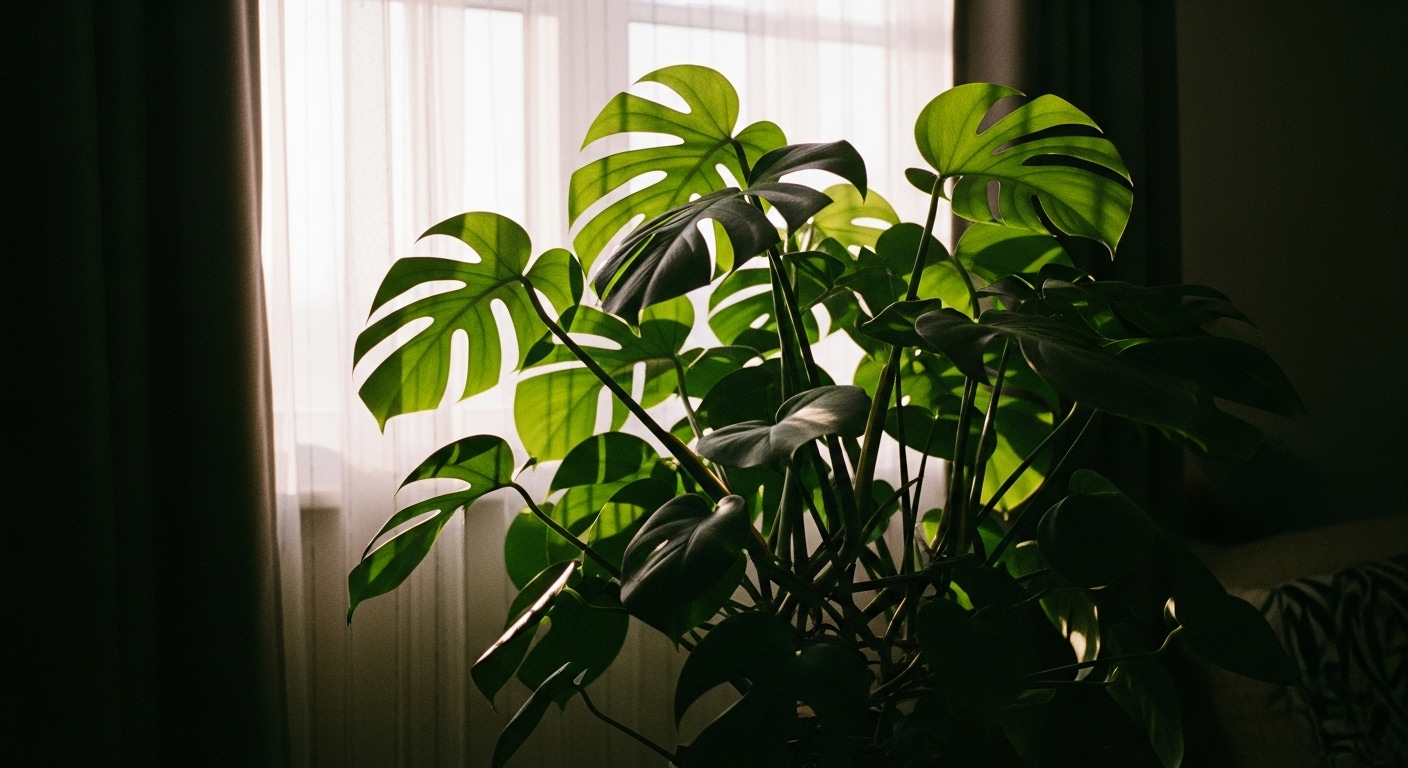 No, they don’t. Swiss cheese plants like to have bright, indirect light. High-quality light, on the other hand, maybe injurious to the leaves.
No, they don’t. Swiss cheese plants like to have bright, indirect light. High-quality light, on the other hand, maybe injurious to the leaves.
They’re Hard to Care For
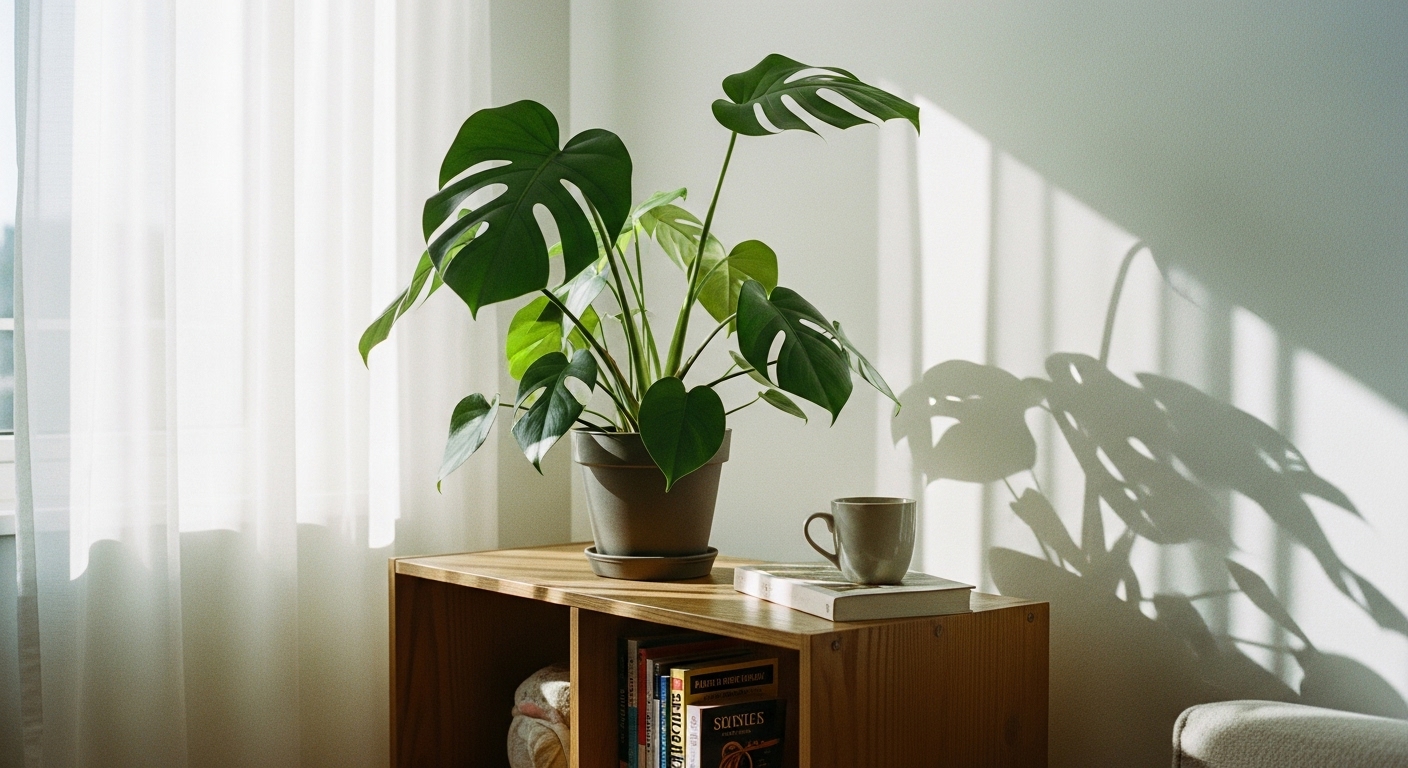 A vast majority of people often wonder, “Is it easy to look after Swiss cheese plants?” The answer is simple. They are low-maintenance plants that can get by with minimal care.
A vast majority of people often wonder, “Is it easy to look after Swiss cheese plants?” The answer is simple. They are low-maintenance plants that can get by with minimal care.
Swiss Cheese Plant Growth Stages
The developmental phases in the life of a Swiss cheese plant are quite important in facilitating proper care during its life cycle.
Mature Swiss cheese plants can grow several feet wide, making them impressive indoor specimens.
Juvenile Stage
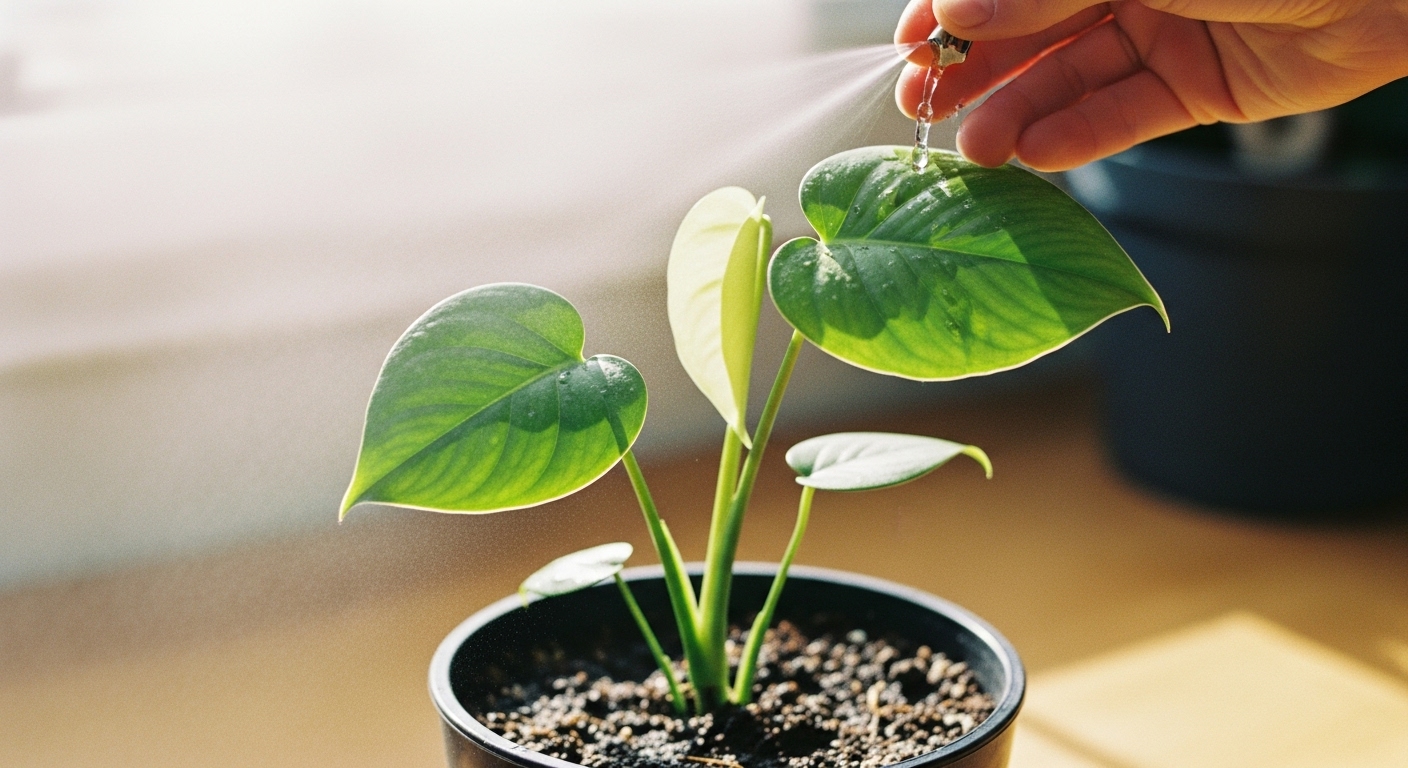 Saplings are delicate plants with small, heart-shaped leaves and no holes. These plants need to be watered more frequently than ones without holes and have to be handled more gently.
Saplings are delicate plants with small, heart-shaped leaves and no holes. These plants need to be watered more frequently than ones without holes and have to be handled more gently.
Mature Stage
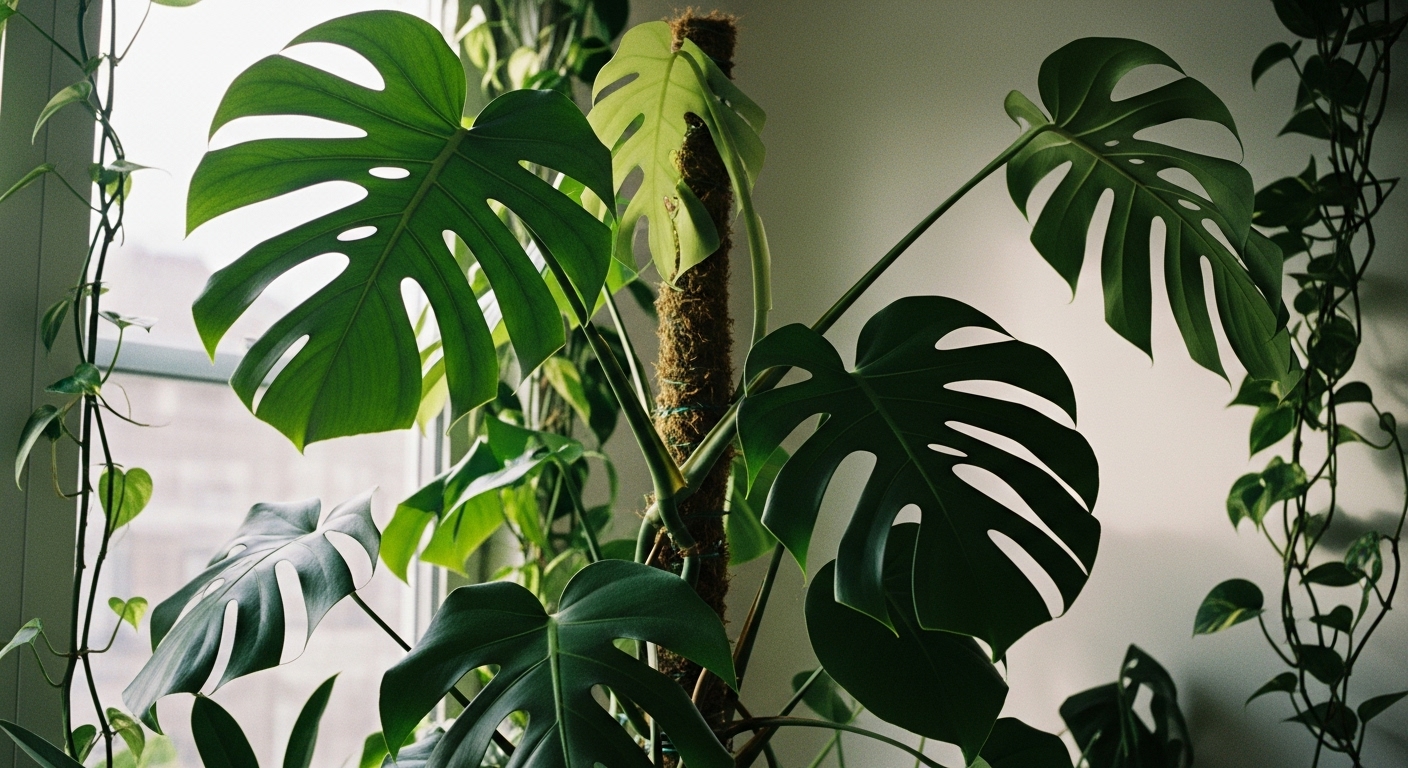 Get older, the leaves would have full holes and slits that they are known for. At the mature stage, the most important thing is to help the plant retain its climbing nature, so we should be very careful with its support system.
Get older, the leaves would have full holes and slits that they are known for. At the mature stage, the most important thing is to help the plant retain its climbing nature, so we should be very careful with its support system.
Conclusion
Though they are thick-leaved, their distinctive foliage makes them preferable as domestic plants. These are the requirements for the regulation of the growing plants, but they are still very easy to maintain. Whether you are a beginner in gardening or an experienced one, you can grow these beautiful plants successfully if you strictly follow the requirements for light, water, soil, and general care.
Swiss cheese is the best if you are looking to turn your home or office into a plant-off-cleaning machine. They can last longer than other decorative plants if you take good care and notice their needs. Promptly, with appropriate care and maintenance, these plants can grow and thrive and will be the main attraction of the surroundings.
FAQs
How often should I water my Swiss cheese plant?
Water at the same intervals as when your 1-inch soil top is fully dry, so around once in 7 to 14 days for plants growing indoors, and 2 to 3 days for outdoor plants.
Why are the leaves on my Swiss cheese plant turning yellow?
When plant leaves turn yellow, you should know you have been overwatering them. Try changing your watering schedule, and the water drainage system should also be taken care of.
Can Swiss cheese plants grow in low light?
These plants prefer light but can survive in dimmer areas. The problem, however, is that their growth will be slower.
How big do Swiss cheese plants get?
In situations of good care, at least 1m of height can be reached by the Swiss cheese plant indoors, while it can even be seven feet tall.
Are Swiss cheese plants toxic to pets?
Irritation, salivation, vomiting diarrhea, and scratching could come, and mild symptoms of ingestion have been observed in pets. One should take care of the pets and children by informing them about the toxic plants and keeping the remains out of their reach. For a comprehensive list of pet-safe and toxic plants, consult the ASPCA’s official resources.
How often should I fertilize my Swiss cheese plant?
During the growing season, that is from March to the end of August, fertilize with a blend of complete fertilizer every month.
Eager to renovate your space with the beautiful Swiss Cheese Plant? Start your plant parenthood journey right now with our complete care guide! Whether you’re a novice or an expert plant thinker, our advice offers guidance for making your Monstera a happy one. There’s no reason to wait – make your home feel tropical and beautiful right away, and let your green friend flourish and thrive effortlessly











































